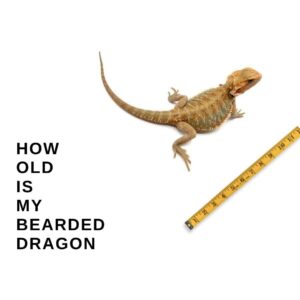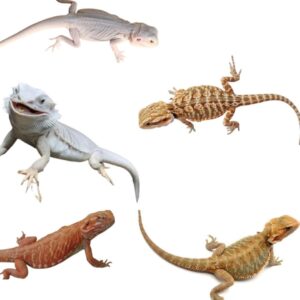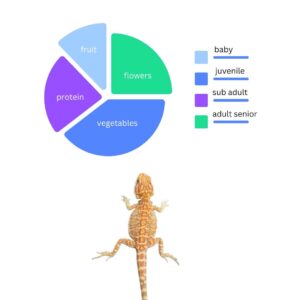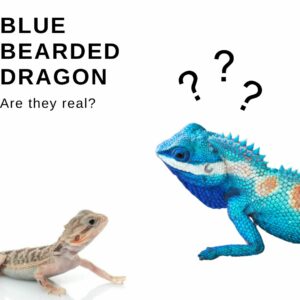Bearded dragons are diurnal creatures, which means they are active during daylight hours. In their natural habitat, they soak up the sun’s rays to regulate their body temperature and facilitate vitamin D synthesis.
Enclosure lighting should mimic the natural cycles for the overall health and well-being of your bearded dragon. It not only aids in maintaining their circadian rhythm but also helps with physiological processes.
So, let’s talk breaded dragon lightning, bulbs, placements, and common mistakes.
Bearded Dragon Lighting: Table of Contents
What are bearded dragon lighting requirements?
Bearded dragons need:
- UBA/UVA lighting to synthesize vitamin D
- Basking light to thermoregulate
- Ceramic Heat Emitters (CHE) to achieve comfortable temperature in larger enclosures
UVB Lighting
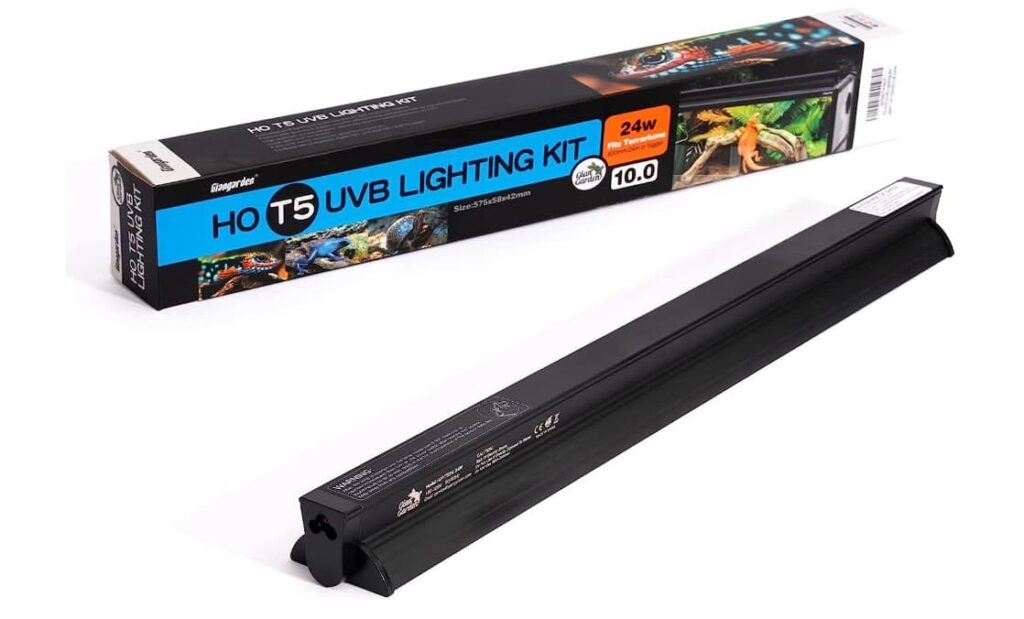
Bearded dragons require UVB lighting to synthesize vitamin D3, essential for calcium absorption and overall health.
UVA Lighting:
UVA light is important for bearded dragons’ vision, behavior, and overall well-being.
UVA light can be provided by using a full-spectrum incandescent bulb or by using the same basking light that emits both UVA and heat.
There are two types of UVB bulbs:
- UVB fluorescent bulbs: UVB fluorescent bulbs emit UVB radiation and are usually mounted inside the tank
- Mercury vapor bulbs: Mercury vapor bulbs, on the other hand, provide both UVB and heat, making them a convenient all-in-one solution for UVB and basking light needs.
Mercury vapor bulb
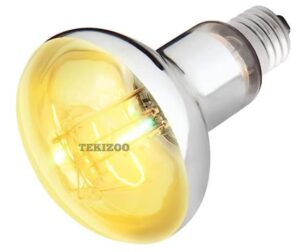
This type of bulb emits both UVA and UVB rays, as well as heat. It is a great all-in-one solution for providing both lighting and supplemental heat for your bearded dragon.
Some bearded dragon owners also opt for a combination of fluorescent tubes and heat lamps. This setup allows for precise control over the temperature gradient within the enclosure, ensuring that your bearded dragon can thermoregulate effectively.
UVB lights placement
The UVB light should be placed inside the enclosure directly above the basking area to provide maximum exposure during the beardie’s most active times.
Fixture Selection
Depending on the type of UVB bulb you choose, there are different fixtures available, such as linear fixtures for tube bulbs or dome fixtures for mercury vapor bulbs. Ensure the fixture is securely mounted and properly sized for the enclosure.
Size of UVB Light
The size of the UVB light should be appropriate for the size of the enclosure. The length of the UVB bulb should cover at least 2/3 of the enclosure’s length to ensure the bearded dragon receives adequate exposure.
The best UVB light for bearded dragons is a fluorescent or mercury vapor bulb with a UVB output of 5% to 10%.
We like the Giangarden T5 HO UVB Lighting Combo Kit, you can browse this or similar lights here.
The UVB bulb should be replaced every 6 to 12 months, as its effectiveness diminishes over time.
To monitor UVB and lamp efficiency you can opt for a UV index meter here.
Basking Light
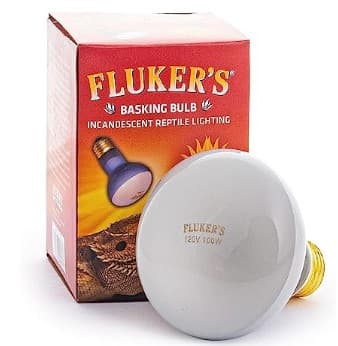
A basking light provides a heat source for your bearded dragon to regulate its body temperature and thermoregulate.
Use a spotlight-style halogen or incandescent bulb with a wattage between 75 to 100 watts, depending on the size of the enclosure.
These lights are affordable and you can find halogen 100 wats bulbs at any store, or you can browse them on Amazon. Here is an example of a good bulb here.
A 100-watt basking bulb is often recommended for a 40-gallon tank, but it’s important to monitor the temperature to ensure it falls within the ideal range of 90-95 degrees Fahrenheit (35 degrees Celsius) at the basking spot.
The basking light should be turned off at night to simulate a natural day/night cycle.
Placement: Basking lights should be positioned at one end of the enclosure to create a temperature gradient, with the basking spot reaching temperatures of 100-110°F (37-43°C) and the cool side around 80-85°F (27-29°C).
Distance: The distance between the basking light and the bearded dragon should be carefully monitored to prevent overheating or burns. It is recommended to follow manufacturer guidelines and monitor the temperature with a reliable thermometer.
Types of Basking Lights
Incandescent Bulbs: These bulbs emit heat and create a basking spot for the bearded dragon. They come in various wattages to provide different levels of warmth.
Halogen Bulbs: Similar to incandescent bulbs, halogen bulbs produce heat and can create a basking area. They are known for their longevity and intense light output.
Mercury Vapor Bulbs: These bulbs are a combination of heat, UVA, and UVB light sources.
They provide both basking heat and essential UV radiation.
Ceramic Heat Emitters (CHE): CHEs do not emit light but generate heat, making them suitable for providing a continuous heat source without disturbing the reptile’s day-night cycle.
Radiant Heat Panels: These panels offer a large heat source that covers a wider area of the enclosure. They are generally used for larger enclosures.
Functions of Basking Lights
Heat Provision: Bearded dragons are ectothermic reptiles and rely on external heat sources to regulate their body temperature. Basking lights create a warm area within the enclosure where the dragon can thermoregulate by moving closer or farther away.
UVB Radiation: Basking lights that emit UVB radiation are crucial for bearded dragons as they require UVB exposure to produce Vitamin D3, which aids in calcium absorption and prevents metabolic bone disease.
Promoting Natural Behaviors: Basking lights replicate the sun’s rays, allowing bearded dragons to engage in natural behaviors like basking, which supports their overall well-being.
Setting up Basking Lights:
Bulb Lifespan
Basking bulbs, especially UVB bulbs, have a limited lifespan. UVB bulbs should be replaced every 6-12 months, as their UV output diminishes over time. Incandescent and halogen bulbs should be replaced when they burn out.
Ceramic Heat Emitters (CHE)
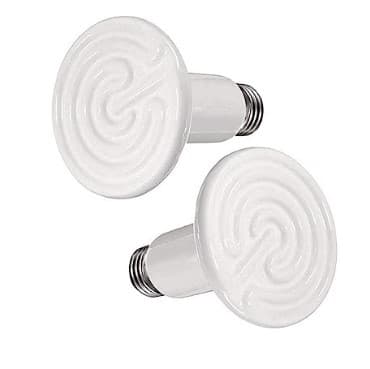
If the temperature drops below 80°F (27°C) at night, you may need a ceramic heat emitter to provide gentle heat without emitting light.
Ceramic heat emitters are recommended for nocturnal heating and should be used with a thermostat to regulate the temperature. You can find them here.
Functions of Ceramic Heat Emitters (CHE) for Bearded Dragons
Temperature Regulation: CHEs emit infrared heat, which helps create a warm basking spot in the bearded dragon’s enclosure. This allows the dragons to thermoregulate by moving between warmer and cooler areas to maintain their preferred body temperature.
Best Practices for Using Ceramic Heat Emitters (CHE) for Bearded Dragons
Wattage Selection: The appropriate wattage of a CHE depends on factors such as the size of the enclosure, ambient temperature, and the need for supplemental heating. It is generally recommended to use a 100-watt CHE for a 30-40 gallon enclosure, but adjustments may be needed based on individual circumstances.
Placement: The CHE should be positioned in a way that provides a basking spot with a temperature range of 100-110°F (38-43°C). The emitter should be placed above the enclosure, preferably attached to a ceramic socket or fixture, with a guard to prevent contact with the dragon.
Thermostat Control: It is crucial to use a thermostat with a CHE to regulate the temperature accurately. The thermostat will turn the CHE on or off as needed to maintain the desired temperature range, ensuring the safety and comfort of the bearded dragon.
Types of Ceramic Heat Emitters (CHE) for Bearded Dragons
OMAYKEY 100W Ceramic Heat Lamp: This ceramic heat emitter is designed specifically for reptiles and can last up to 15 hours, depending on the model. It has a flat design and is made of durable ceramics, providing long-lasting and efficient heat emission.
Fluker’s Ceramic Heat Emitter: Another popular brand, Fluker’s offers ceramic heat emitters suitable for various reptiles, including bearded dragons. They are known for their reliability and effectiveness in maintaining proper temperatures in reptile habitats.
Simple Deluxe Ceramic Heat Emitter: This budget-friendly option is suitable for bearded dragons and other reptiles. It provides consistent heat and is designed to last.
Remember to always follow the manufacturer’s instructions and consult with a reptile veterinarian or experienced reptile keeper for personalized guidance on using Ceramic Heat Emitters (CHEs) for your bearded dragon’s specific needs.
Lighting fixtures
When it comes to lighting fixtures for bearded dragons, there are different types available, each serving specific purposes. Here are some common types of lighting fixtures and their best uses for bearded dragons:
Fluorescent Fixture
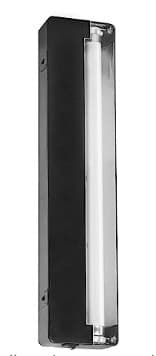
Browse fluorescent light fixtures for bearded dragons here.
Best for: UVB bulbs
Fluorescent fixtures are designed to hold linear UVB bulbs, which provide the necessary UVB radiation for bearded dragons. These fixtures come in various lengths to accommodate different bulb sizes.
Incandescent Fixture
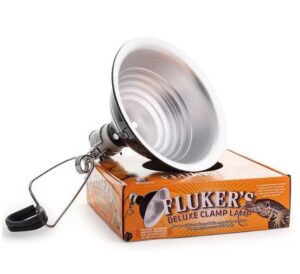
Best for: Basking bulbs
Incandescent fixtures are suitable for holding basking bulbs, which emit heat and create a basking spot in the enclosure. These fixtures typically have a reflective dome or hood that helps direct the heat downward.
You can browse Incandescent Fixtures here.
Ceramic Socket Fixture
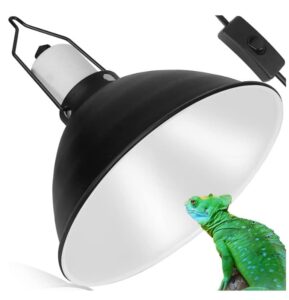
Best for: Ceramic heat emitters (CHEs)
Ceramic socket fixtures are designed to hold ceramic heat emitters (CHEs), which emit infrared heat without emitting light. They are ideal for providing supplemental heat in the enclosure, especially during nighttime or colder periods.
you can browse this or similar ceramic fixtures here.
Dual Fixture
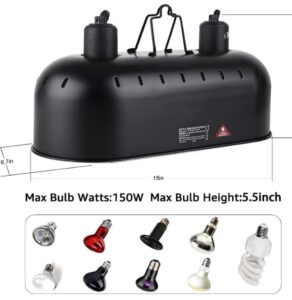
Best for: Combining UVB and basking bulbs
Dual fixtures feature separate compartments for UVB bulbs and basking bulbs, allowing you to provide both the necessary UVB radiation and heat in one fixture. This type of fixture can be convenient for space-saving and easy installation.
you can browse this or similar duel fixtures here.
Clamp Lamp Fixture
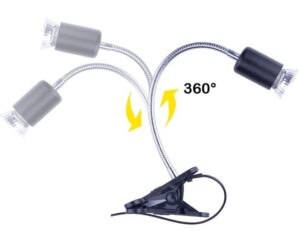
Best for: Spot heating or specific areas
Clamp lamp fixtures consist of a metal clamp attached to a socket, allowing you to attach the fixture to various surfaces. They are versatile and can be used to provide targeted heat or lighting in specific areas of the enclosure.
You can find this or similar fixtures here.
Dome Fixture
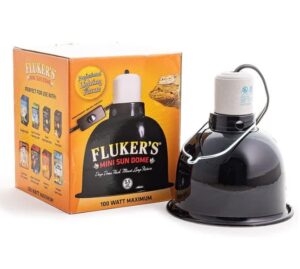
Best for: Heat lamps or specialized bulbs
Dome fixtures are dome-shaped and can accommodate different types of bulbs, including heat lamps or specialized bulbs. They often have an adjustable neck or arm, allowing you to direct the light or heat where needed.
you can find dome fixtures here.
Lighting Schedule for bearded dragons
Bearded dragons should have a photoperiod of 12 to 14 hours of light per day, followed by 10 to 12 hours of darkness for rest.
Beardies’ parents sometimes include infrared lighting during the night. While it looks cool, I don’t recommend any lights during nighttime (only temperature maintenance) because this can disrupt the sleep-wake cycle and future health issues.
Ceramic heat emitters (CHE) are another option for providing heat without light emission. They can be used as a basking bulb or as a supplemental heat source at night.
Using timers for the lighting system can help automate this process, ensuring that the light cycle remains consistent even when you are not around to manually adjust it. Maintain a gradual transition between light and darkness to mimic natural lighting changes.
Bearded dragon lighting at night
Think of their natural habitat, in Australian deserts there are are no light during the night. Best is to turn off the lights at night.
Daiy bearded dragon lighting
During the day, they need lots of light. You can opt for UVA/UVB and basking light. The enclosure should be bright without dark areas during the day.
Common Mistakes in Bearded Dragon Lighting
Even with the best intentions, it’s easy to make mistakes when setting up an optimal lighting system for your bearded dragon. Let’s explore some common mistakes to avoid:
1. Overexposure to UV Light
While UVB lighting is crucial, overexposure can also be detrimental to your bearded dragon’s health. Excessive exposure to UVB rays can lead to sunburn, skin damage, or eye problems.
Follow the recommended guidelines and make sure the UVB light is not too close to your bearded dragon’s basking spot.
2. Incorrect Light Temperature
Bearded dragons require a specific temperature gradient in their enclosure, with a basking spot around 95 to 105 degrees Fahrenheit (35-40 degrees Celsius).
Monitor the temperature using a thermometer and adjust the position or wattage of the bulbs accordingly.
My Senior Paws is a participant in the Amazon Services LLC Associates Program, an affiliate advertising program designed to provide a means for sites to earn advertising fees by advertising and linking to Amazon.com. We also participate in other affiliate programs which compensate us for referring traffic.

